2. 中国科学院地质与地球物理研究所油气资源研究重点实验室, 兰州 730000
2. Lanzhou Center for Oil and Gas Resources, Institute of Geology and Geophysics, Chinese Academy of Sciences, Lanzhou 730000, China
新生代火山和地热活动能够持续地向当今大气圈释放巨量的温室气体(Werner et al., 2008; Dasgupta and Hirschmann, 2010; Kelemen and Manning, 2015),并已经成为研究全球深部碳循环和自然来源温室气体释放通量的重要场所(Burton et al., 2013),其释放温室气体的类型,主要包括喷气孔、温(热)泉和土壤微渗漏等(Bergfeld et al., 2001; Etiope et al., 2007; 郭正府等, 2010)。已有研究表明,板块边界(例如,俯冲带和洋中脊)与板块内部(例如,大火成岩省)的火山活动是地球深部碳排放的重要通道(Fischer et al., 1998; Marty and Tolstikhin, 1998; Sano et al., 2014)。以往的调查研究大多侧重于大洋俯冲带、洋中脊和大火成岩省等构造背景的新生代火山-地热活动释放的温室气体总量及其成因(Resing et al., 2004; Shinohara, 2013; Schmidt and Poli, 2014; Kelemen and Manning, 2015; Zellmer et al., 2015),而关于大陆俯冲带新生代火山-地热区温室气体释放通量与成因的研究,迄今为止,相关的报道则相对较少(郭正府等, 2014; 张丽红等, 2014)。作为地球上独一无二的特殊地质单元,青藏高原是印度-亚洲大陆俯冲带的重要组成部分,对新生代全球气候变化具有至关重要的影响(An et al., 2001; Guo et al., 2002; Dupont-Nivet et al., 2007; Wu et al., 2012; Zheng et al., 2015)。新生代时期,印度大陆与亚洲大陆之间的碰撞和俯冲导致青藏高原南部发生了大规模的火山活动(丁林等, 2006; 莫宣学等, 2006; 赵志丹等, 2006; Zhao et al., 2009; 陈建林等, 2010; Guo et al., 2013, 2015; Zhu et al., 2015),并形成了数量众多的地热分布区(Hoke et al., 2000; 赵平等, 2002; 侯增谦和李振清, 2004)。目前这些火山-地热区的温(热)泉、喷气孔、土壤微渗漏等水热活动仍然异常活跃,正在向大气圈释放大量的温室气体(郭正府等, 2014, 2015; 张丽红等, 2014),其释放潜力与规模值得给予足够重视。
伴随印度-亚洲大陆的碰撞和俯冲作用,青藏高原南部发生大规模的隆升和伸展作用,形成了7条近NS向的拉张性裂谷(图 1a, Coleman and Hodges, 1995; Blisniuk et al., 2001; Williams et al., 2001)。其中,谷露-亚东裂谷是青藏高原南部规模最大、延伸最长的裂谷,说明该裂谷正处于岩石圈伸展拉张的初始阶段(8~12Ma; Harrison et al., 1995; Edwards and Harrison, 1997; Wu et al., 1998),强烈的地热活动和新生代火山作用(Furlong and Chapman, 2013; 张丽红等, 2014; Zhang et al., 2017)也显示该裂谷具有极高的热流值,目前正在向大气圈释放着巨量的温室气体。近期,作者所在的研究组对裂谷内某些局部地点尝试性地开展了实地考察与初步测量,结果显示,仅羊八井地热区的土壤微渗漏CO2释放通量就高达8.6×104t·a-1(郭正府等, 2014; 张丽红等, 2014),与意大利Vulcano火山区的土壤微渗漏温室气体释放规模(1×105t·a-1)相当。这些研究工作与初步成果为研究组在青藏高原新生代火山-地热区开展长期而系统深入的温室气体释放通量与成因研究提供了实际经验与技术保障。此外,为了获取被国际谈判认可的高质量地质源碳排放数据和研究成果,研究组在测区选择、测点布局、温室气体的原位测量技术以及大陆俯冲带新生代火山-地热气体所反映的动力学过程等方面的研究都需要进一步加强与提高。因此,结合以往的研究工作,在谷露-亚东裂谷选择谷露、羊八井和羊应等3个典型的火山-地热区,开展了系统的温室气体释放通量的实地测量与成因研究,其预期成果不仅对于探索大陆俯冲带新生代火山-地热区的温室气体释放规模及其环境效应具有重要的科学意义,而且对于进一步评估人类活动对大气圈温室气体含量增加的相对贡献具有重要的科学价值与现实意义。
2 地质背景谷露-亚东裂谷位于青藏高原东南部,是新生代时期青藏高原岩石圈伸展拉张作用形成的规模最大、延伸最长的裂谷(图 1a; 廖志杰和赵平, 1999; Liu et al., 2004)。裂谷内发育大规模高角度正断层将裂谷一分为二,在两侧发育高海拔山地,例如,北东-南西走向的念青唐古拉山(图 1b; Harrison et al., 1995; 吴珍汉等, 2005)。裂谷内小型断裂和裂隙密集发育(李家振等, 1992, 1994; 刘昭, 2014)。
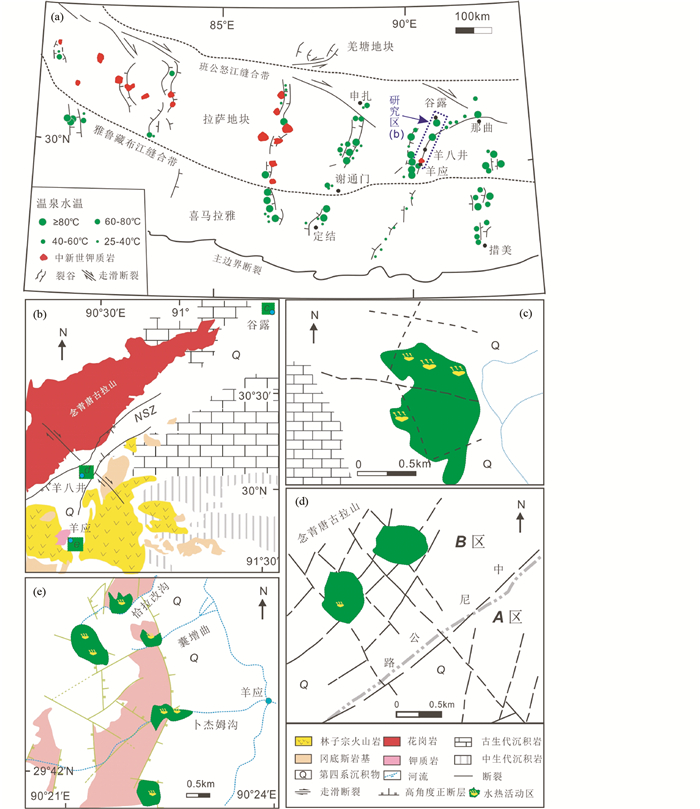
|
图 1 青藏高原南部火山-地热区地质简图 (a) 青藏高原南部火山-地热区分布图(据侯增谦等, 2001; 侯增谦和李振清, 2004; Guo et al., 2013; 刘昭, 2014);(b) 谷露-羊八井裂谷火山-地热区分布图(据Yokoyama et al., 1999; 张丽红等, 2014), NSZ-念青唐古拉山伸展性韧性剪切带;(c) 谷露地热区地质简图(刘昭, 2014);(d) 羊八井地热区地质简图(张丽红等, 2014);(e) 羊应火山-地热区地质简图(李家振等, 1994; Zhang et al., 2017) Fig. 1 Geologic map of volcanic-geothermal fields in the South Tibet (a) distributions of volcanic-geothermal fields in the South Tibet (after Hou et al., 2001; Hou and Li, 2004; Guo et al., 2013; Liu, 2014); (b) distributions of volcanic-geothermal fields in the Gulu-Yangbajing rift (after Yokoyama et al., 1999; Zhang et al., 2014), NSZ-Nyainqentanglha shear zone; (c) geologic map of Gulu geothermal fields (after Liu, 2014); (d) geologic map of Yangbajing geothermal fields (after Zhang et al., 2014); (e) geologic map of Yangying volcanic-geothermal fields (after Li et al., 1994; Zhang et al., 2017) |
裂谷北部出露的主要地层包括前寒武纪角闪岩相变质岩、石炭系浅变质岩和上白垩统紫红色砂砾岩(Kapp et al., 2005; 吴珍汉等, 2005);而裂谷南部出露的地层主要以岩浆岩为主,包括晚白垩纪-第三纪的林子宗火山岩和冈底斯岩基(Ji et al., 2009; Lee et al., 2012)、不同时代的念青唐古拉山花岗岩(Liu et al., 2004; Weller et al., 2016)、中新世的埃达克岩和钾质岩浆岩(Coulon et al., 1986; Nomade et al., 2004; Guo et al., 2007; 王保弟等, 2011; Yang et al., 2015)。此外,第四纪沉积地层沿整条裂谷广泛分布(Yokoyama et al., 1999; 刘昭, 2014)。
谷露-亚东裂谷的水热活动十分强烈,水热活动类型多样,包括温泉、热泉、沸泉、喷气孔和土壤微渗漏等(图 2),其中沸泉的最高温度可达92℃(侯增谦等, 2001; 赵平等, 2002)。此外,地球物理资料显示,谷露-亚东裂谷下部的中上地壳(15~20km)存在低速高导层或地震亮点(Zhao et al., 1993; Brown et al., 1996; Nelson et al., 1996; Wei et al., 2001)。火山岩矿物温压计算结果同样表明,谷露-亚东裂谷带内新生代火山岩的岩浆囊深度约为11.6~16.4km (Zhang et al., 2017)。上述信息说明谷露-亚东裂谷下部的低速高导层可能是地壳或地幔物质熔融残留的岩浆囊(Yokoyama et al., 1999; Zhang et al., 2017),该岩浆囊为谷露-亚东裂谷带的温室气体提供了充足的热能和物质来源。因此,谷露-亚东裂谷是青藏高原新生代火山-地热活动与深部碳排放的典型代表,是开展温室气体释放规模调查研究的理想场所。
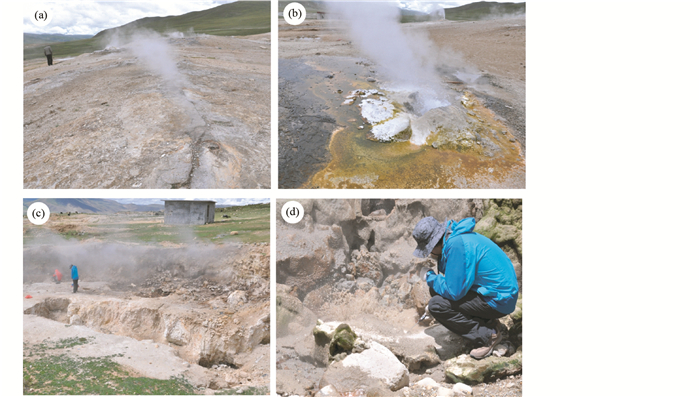
|
图 2 谷露和羊应火山-地热区温室气体的释放类型 (a) 谷露喷气孔/喷气裂隙;(b) 谷露喷泉;(c) 羊八井土壤微渗漏;(d) 羊应沸泉 Fig. 2 Forms of gas-releasing in the Gulu and Yangying volcanic-geothermal fields Fumaroles/steaming fissure (a) and geysers (b) in Gulu geothermal field; (c) soil micro-seepage in Yangbajing geothermal field; (d) boiling springs in Yangying volcanic-geothermal field |
土壤微渗漏CO2释放通量的测量方法多种多样,经过实践检验,密闭气室法是目前国内外公认的测量火山-地热区土壤微渗漏CO2释放通量的最佳方法(Tonani and Miele, 1991; Chiodini et al., 1998; Burton et al., 2013)。密闭气室法的原理为,通过记录密闭气室内CO2的累积浓度随时间的变化关系,计算测试点土壤微渗漏CO2的释放通量。在开展温室气体释放通量野外测量工作时,首先对火山-地热区的断裂、岩石类型、地层和水热活动强度等进行系统考察,划分土壤微渗漏CO2释放级别和类型,然后选择远离河流、植被密集和人类活动影响较小的区域,按照50~100m布设一点的原则进行网格式密集布点,之后采用便携式红外线CO2通量测量仪,测量土壤微渗漏CO2浓度随时间的变化关系。详细测试流程见张丽红等(2014)。谷露和羊应火山-地热区土壤微渗漏CO2释放通量的部分测试结果见表 1。
|
|
表 1 谷露和羊应火山-地热区土壤微渗漏的CO2气体浓度(×10-6)与释放通量(g·m-2·day-1)测量结果 Table 1 The micro-seepage soil CO2 concentration (×10-6) and flux (g·m-2·day-1) of Gulu-Yangying volcanic-geothermal field |
气体样品的采集需要保证足够的样品量以满足实验室测试分析,同时,又要避免样品采集运输过程中的空气污染问题,目前,国际通用的采样方法是“预真空采样法”,不仅可以用于温泉气体样品的采集,也可以用于采集土壤微渗漏气体样品(张茂亮等, 2011; 郭正府等, 2015)。主要的集气装置包括手动抽气泵、集气瓶/袋(铝箔袋)、过滤器和中空不锈钢管/漏斗。青藏高原地区不仅空气稀薄,气压低,而且气温也低,一般的玻璃瓶常因温度和气压变化而发生碎裂,因此,不得已的情况下采用铝质塑料样品袋采集温泉气体样品。收集温泉逸出气体时,将漏斗倒置于温泉水中气泡较多的位置并确保漏斗没入水面以下,取样前,使用手持抽气泵反复抽取集气装置约5~10min,直至将管道中的空气全部排净,避免残留大气对样品的污染,然后利用集气瓶/袋收集气体。土壤微渗漏气体的采集方法与采集温泉逸出气体的方法类似,为尽量排除土壤中地表大气的干扰,需将中空不锈钢管楔入地下约1~1.5m,连接手持抽气泵、橡胶管和集气瓶/袋等集气装置,利用抽气泵将集气装置中的空气排净,然后采集土壤微渗漏气体。详细气体采集流程见Walia et al. (2005)和Zhang et al. (2015)。
3.3 气体组分与同位素测试方法土壤微渗漏和温泉气体样品的化学组分和同位素组成是在中国科学院地质与地球物理研究所兰州油气资源研究中心测试完成的。其中,气体组分采用MAT-271气体质谱仪测定,测试的气体组分包括CO2、N2、O2、CH4、He和H2S等;稳定碳同位素采用MAT-252稳定同位素质谱计测试;He同位素采用MM-5400稀有气体质谱仪测定,详细测试流程见文献Luo et al. (2014)和Zhang et al. (2015)。气体组分和同位素成分测试结果见表 2。
4 结果 4.1 土壤微渗漏CO2释放通量在野外测量的基础上,根据土壤微渗漏CO2释放通量的计算原理(Chiodini et al., 1998; 郭正府等, 2014; 张丽红等, 2014),拟合了研究区土壤微渗漏CO2的累积浓度随时间变化的函数,通过计算初始斜率获得测点土壤微渗漏CO2释放通量的结果(表 1)。其中,谷露地热区的土壤微渗漏CO2释放通量的范围为0.2~1967g·m-2·day-1;羊应火山-地热区CO2释放通量为2.3~1113g·m-2·day-1。计算结果显示,同一火山-地热区各测试点的CO2释放通量存在明显差异(图 3a),说明土壤微渗漏CO2的释放是不均匀的,通量的大小可能与研究区地层的联通性有关,例如,土壤的渗透性和断层发育程度(Lan et al., 2007; Zhang et al., 2015)。以往的研究也表明,断裂带区域经常伴随较高的土壤微渗漏温室气体释放通量(Baubron et al., 2002; Lewicki et al., 2003; Fu et al., 2005; Hutchison et al., 2015)。谷露和羊应火山-地热区紧邻念青唐古拉东南麓低角度韧性剪切带(图 1b),区内小型断裂密集展布(李家振等, 1992; 赵平等, 2001),为土壤微渗漏温室气体的释放提供了良好的运移通道。
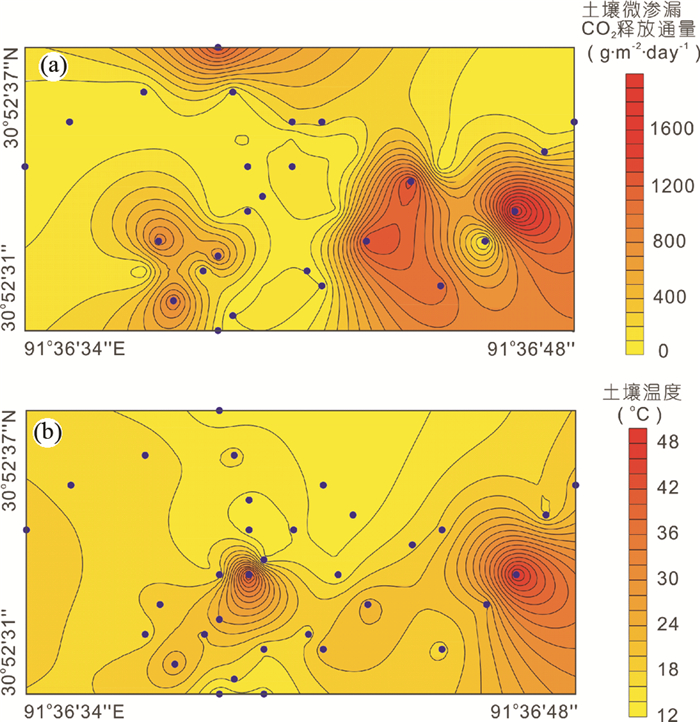
|
图 3 谷露地热区土壤微渗漏CO2释放通量和土壤温度等值线图 (a) 土壤微渗漏CO2释放通量等值线图;(b) 土壤温度等值线图 Fig. 3 Contour map showing soil temperature and CO2 fluxes of the Gulu geothermal field (a) soil temperature contour map; (b) soil CO2 fluxes contour map |
土壤微渗漏CO2释放通量和土壤温度等值线图(图 3)显示,释放通量较强烈的区域与土壤温度较高的区域大致重合。同时,结合野外地质考察结果,土壤温度较高的区域与地表水热活动强烈的区域也表现为较高的一致性。因此,上述特征说明强烈的水热活动区即代表强烈的温室气体释放区。
4.2 气体组分与同位素组成谷露地热区土壤微渗漏和温泉气体的化学成分具有二氧化碳高含量,氩气和氧气低含量的特点,其中CO2含量为89.8%~96.1%,Ar含量为0.04%~1.35%,O2含量小于 < 3%,代表性的测点(样品)分析数据见表 2。这些数据表明,谷露地热区属于典型的富CO2型的地热区;同时,较低的O2含量也说明,气体样品的采集和运输过程中没有受到空气的混染(Roulleau et al., 2015a)。谷露地热区气体的N2/Ar比值为39.2~97.7,介于饱和地下水N2/Ar比值40(Hamme and Emerson, 2004)和大气N2/Ar比值83.6(Marty et al., 1991)之间,说明地热区气体在向上运移过程中可能受到大气组分的混染(图 4)。另外,较低的4He/20Ne比值(0.32~84.1),部分值接近大气4He/20Ne比值(0.318; Sano et al., 1989),也说明气体在上升过程中可能与循环的地下水发生过交换,进而受到大气的混染作用。因此,He同位素比值必须经过大气校正。经大气校正后,谷露地热区样品的3He/4He比值范围为0.22~0.29RA(RA=1.4×10-6, RA为大气中的He同位素比值; Sano and Wakita, 1985),高于地壳的3He/4He比值(0.05RA; Andrews, 1985),但明显低于大洋岛弧(7.4±1.3RA; Sano and Fischer, 2013)和洋中脊玄武岩(MORB)的值(8.0±1.5RA; Sano and Fischer, 2013)。CO2/3He比值为2.09×1010~1.67×1011(表 2),远高于地幔CO2/3He比值(1.5×109; Sano and Marty, 1995)和大洋岛弧岩浆的CO2/3He比值(15.7±11)×109; Sano and Williams, 1996),接近地壳端元值(108~1014; O’Nions and Oxburgh, 1988),显示研究区的气体可能主要来源于地壳。谷露地热区气体样品的δ13CCO2值范围为-2.03‰~-0.78‰,高于地幔值(-8‰~-5‰; Ray et al., 1999),落入海相灰岩的范围(0±2‰; Maheshwari et al., 1999),说明其碳组分可能主要受到灰岩脱气作用的影响。
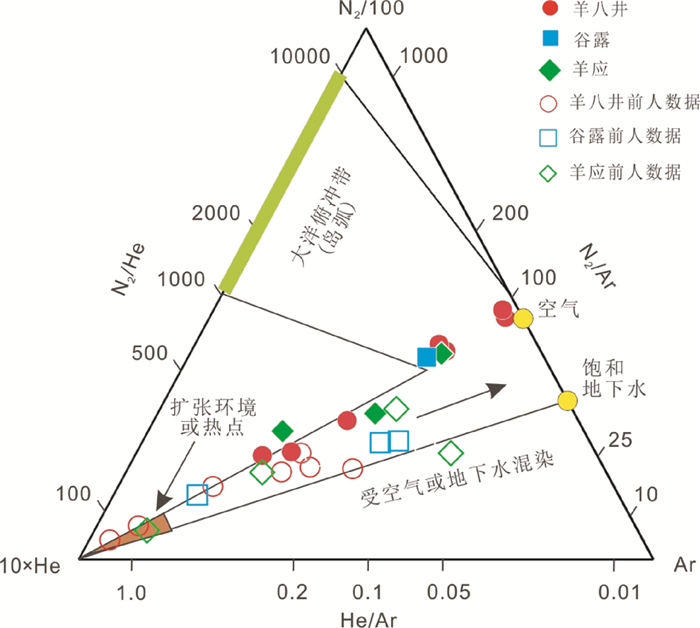
|
图 4 N2-Ar-He图解(底图据Lan et al., 2007) Fig. 4 Ternary plot of N2, Ar and Heof soil and hot springs gases from Gulu-Yangbajing-Yangying volcanic-geothermal filed (modified after Lan et al., 2007) |
|
|
表 2 谷露、羊八井和羊应火山-地热区土壤微渗漏和温泉气体组分和同位素成分 Table 2 Chemical and isotopic composition of the soil and bubbling gases from Gulu, Yangbajing and Yangying volcanic-geothermal fields |
羊应和羊八井火山-地热区气体具有较高的CO2(45.4%~94.6%)含量和较大的O2(0.63%~9.34%)变化范围,说明气体可能受到了大气的混染;经大气校正后的He同位素比值介于0.10RA和0.21RA之间,明显低于谷露地热区的He同位素比值。其CO2/3He比值介于1.35×1010~9.36×1011(表 2),高于地幔CO2/3He比值和大洋岛弧岩浆的CO2/3He比值,接近地壳端元的值。同时羊应火山-地热区气体具有较轻的δ13CCO2值(-7.2‰~-6.76‰),高于有机沉积物(-30±10‰; Hoefs, 2009),而接近地幔的比值(-8‰~-5‰; Ray et al., 1999)。
5 讨论 5.1 土壤微渗漏CO2的释放规模 5.1.1 土壤微渗漏CO2的平均释放通量及其控制因素本研究采用Sinclair (1974)提出的累积概率分布曲线方法,计算火山-地热区的平均释放通量(图 5)。根据土壤微渗漏CO2的来源及累积概率分布曲线的特点(Chiodini et al., 2008, 2015),将CO2释放通量划分为3组:(1) 外生成因CO2的释放通量,通常也被称为生物成因的CO2释放通量。研究表明,生物成因的CO2释放通量的范围通常介于0.2~21g·m-2·day-1,仅在少数情况下(例如,在农田或牧场等),可以检测到更高生物成因的CO2释放通量,甚至达到40~50g·m-2·day-1(Chiodini et al., 2008);(2) 内生成因CO2的释放通量,是指地球深部来源的CO2释放通量,例如,岩浆或地热脱气(Chiodini et al., 1998, 2001, 2007);(3) 内生与外生混合成因CO2的释放通量。因此谷露地热区CO2释放通量可以划分为:A1组,0.15~29.6g·m-2·day-1;A2组,41.5~248g·m-2·day-1和A3组,721~1967g·m-2·day-1。在此基础上,计算各组CO2平均释放通量及其权重,利用CO2平均释放通量计算公式(张丽红等, 2014),计算得到谷露地热区CO2的平均释放通量为437g·m-2·day-1(表 3和图 5a);同理,计算获得羊应火山-地热区的CO2平均释放通量为99g·m-2·day-1(表 3和图 5b)。
|
|
表 3 谷露和羊应火山-地热区土壤微渗漏CO2平均释放通量 Table 3 Estimated parameters and partitioned populations of soil CO2 fluxes in Gulu and Yangying volcanic-geothermal fields and the Total diffuse CO2 output in the GYR |
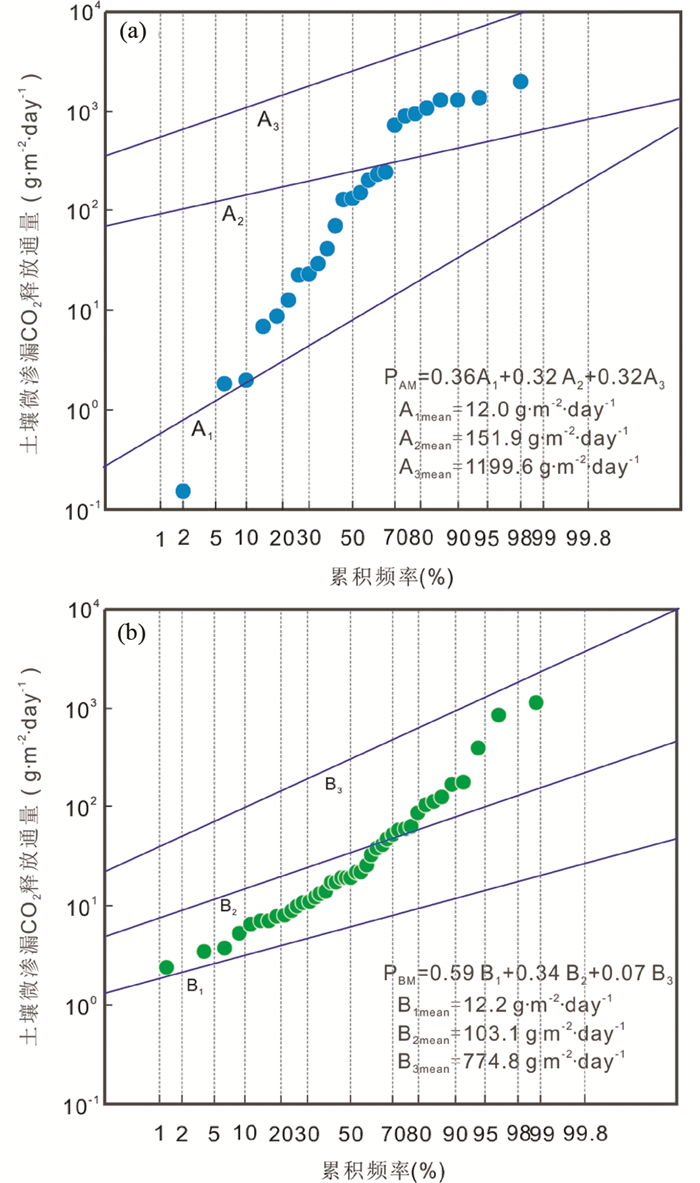
|
图 5 谷露和羊应火山-地热区土壤微渗漏CO2释放通量的对数累积频率分布图 (a) A1、A2和A3分别为谷露地热区三组子样本释放通量的累积频率曲线;(b) B1、B2和B3分别为羊应火山-地热区三组子样本释放通量的累积频率曲线 Fig. 5 Log probability plot for log soil CO2 flux values measured in Gulu (a) and Yangying (b) volcanic-geothermal fields |
谷露-亚东裂谷下部发育岩浆囊(Brown et al., 1996; Xie et al., 2016; Zhang et al., 2017),炙热的岩浆发生脱气作用,并烘烤上覆围岩,为地表水热活动提供了充足的热量和气体。然而通过对比3个火山-地热区土壤微渗漏CO2的平均释放通量,结果显示,谷露地热区土壤微渗漏CO2的平均释放通量最高,是羊应火山-地热区和羊八井地热区(98.5g·m-2·day-1和6.7g·m-2·day-1)的4倍。通过详细的野外地质考察,我们认为导致释放通量存在上述差异的原因可能主要包括:①地壳围岩性质,例如,谷露地热区出露的地层包括含碳酸岩矿物的复理石沉积、灰岩和板岩(Kidd et al., 1988; Yokoyama et al., 1999),而羊应和羊八井火山-地热区主要出露以林子宗火山岩、冈底斯岩基、钾质火山岩和念青唐古拉山花岗岩为主的硅酸岩,炙热的岩浆在烘烤含碳酸岩矿物的地层时,将会产生更多的CO2,为谷露地热区较高的CO2平均释放通量提供了充足的气体来源;②断裂的发育程度,与羊应和羊八井火山-地热区相比,谷露地热区内断裂极为发育,甚至地表也可见到多条裂隙,这些裂隙为土壤微渗漏和水热活动温室气体的释放提供了良好的运移通道(图 2a),在地表的水热活动类型(喷气孔、喷气裂缝、沸泉和高温喷泉等)多样、规模也十分强烈(图 2a, b)。综述所述,我们认为谷露-亚东裂谷内火山-地热区CO2平均释放通量的大小主要受岩浆囊、上覆围岩和断裂活动等因素控制。
此外与全球其它典型的火山-地热区相比,谷露和羊应火山-地热区具有较高的土壤微渗漏CO2释放通量。例如,谷露地热区的土壤微渗漏CO2平均释放通量为437g·m-2·day-1,与美国黄石公园火山的土壤微渗漏CO2平均释放通量(410g·m-2·day-1; 表 4)相当;而羊应火山-地热区(99g·m-2·day-1)与羊八井地热区(98.5g·m-2·day-1)的土壤微渗漏CO2的平均释放通量,接近于加利福尼亚州的Mammoth Mountain火山区的CO2平均释放通量(108g·m-2·day-1; 表 4),这些特征说明谷露-亚东裂谷带的深部地热流体活动非常剧烈,是深部碳排放的主要运移通道。
|
|
表 4 谷露,羊应与世界其它典型的新生代火山-地热区土壤微渗漏CO2的释放规模 Table 4 CO2 output diffused by Gulu, Yangying and other typical volcanic-geothermal of the world |
大量研究表明,土壤微渗漏CO2的释放规模是由土壤微渗漏CO2的平均释放通量与释放面积共同决定的(Chiodini et al., 1998, 2007, 2015)。其中,释放面积是确定土壤温室气体释放规模非常重要的一个因素。目前国际上用于估算土壤微渗漏CO2释放面积的主要方法是,通过实测地质填图、观测设备(例如,航拍照片、遥感卫星)等技术手段,估算和划定水热活动、火山岩或断裂的分布范围,进而估算土壤微渗漏温室气体的释放面积(Newell et al., 2008; Werner et al., 2008; 李辉等, 2011; Hutchison et al., 2015)。
谷露地热区位于谷露-亚东裂谷的北段,区内发育NW-SE向的正断裂和NE-SW向的隐伏断层(图 1c; 刘昭, 2014),土壤微渗漏、喷气孔、喷气裂缝、沸泉和高温喷泉等水热活动主要沿断裂分布(图 2a, b)。通过野外实地考察和地质分布图划定断裂、水热活动带,估算了谷露地热区释放土壤微渗漏CO2的面积为0.26km2。同理,估算了羊应水热活动带和土壤微渗漏释放CO2的释放面积为1.5km2(图 1e; 李家振等, 1992, 1994)。
基于以上野外调查和资料分析,采用土壤微渗漏CO2的释放规模的计算公式(郭正府等, 2014; 张丽红等, 2014),估算了谷露和羊应火山-地热区每年向大气中释放的土壤微渗漏CO2的释放规模,分别为4.15×104t和5.42×104t。如果结合羊八井地热区土壤微渗漏CO2释放规模(8.59×104t·a-1; 郭正府等, 2014; 张丽红等, 2014),那么仅谷露、羊八井和羊应等3个火山-地热区每年向大气圈释放的CO2总量就高达1.81×105t,接近喜马拉雅隆升变质脱碳过程产生的CO2总量(4.4×105t·a-1; Kerrick and Caldeira, 1999)。考虑到谷露-亚东裂谷内发育近20余处火山-地热区(刘昭, 2014),并且这些火山-地热区内的水热活动目前仍然异常活跃,因此若对这些火山-地热区逐一进行测量,并估算其土壤微渗漏的释放规模,其CO2释放规模将是非常惊人的。但是,在面积如此广大的裂谷内(长约300km, 宽约15~20km; Cogan et al., 1998; 贺日政和高锐, 2003),精细测量并准确估算出每个火山-地热区的温室气体释放通量是非常困难的。
基于此,如果假设谷露、羊八井和羊应3个火山-地热区的平均CO2释放通量(160g·m-2·day-1)可以代表裂谷内火山-地热区土壤微渗漏CO2的释放强度,并且考虑谷露-亚东裂谷内火山-地热区的总体面积为300km2(长度为300km,宽度1km),采用土壤微渗漏CO2的释放规模的计算公式,对谷露-亚东裂谷内新生代火山-地热区每年以土壤微渗漏的形式向大气圈释放的CO2总量进行计算,其结果为1.76×107t,非常接近西提斯俯冲带意大利Apennine地区火山-地热区每年向大气中释放的CO2总量1.32×107t (表 4)。对比结果表明,东西特提斯构造域温室气体的释放特征可能具有很好的一致性,显示大陆俯冲带是温室气体释放的重要场所。此外,这些研究工作和初步成果也为我国自然因素碳排放总量提供了仅有的来自大陆俯冲带背景下的火山-地热区的温室气体释放通量数据。
5.2 藏南新生代火山-地热区气体来源与成因火山-地热区释放的气体能够携带固体地球不同圈层(地壳、地幔和地核)的地球化学信息,反映不同构造背景下的气体地球化学演化过程及其成因机制(Hilton et al., 1998, 2002)。因此,对青藏高原南部拉张性裂谷带新生代火山-地热区温室气体的成因开展研究,深入分析气体的地球化学特征及其对相关的物理-化学过程的响应,不仅能够完善大陆俯冲带火山-地热气体的地球化学理论体系,而且也可以为示踪火山-地热气体(包括CO2等温室气体)的来源、物质再循环,以及大陆俯冲地球动力学过程等提供地球化学依据。
5.2.1 He同位素组成及其源区作为惰性气体元素,He同位素因化学性质稳定,在上升过程中只涉及物理过程而不发生化学反应,被称为识别源区特征的重要指标(Burnard, 2013)。He的稳定同位素中,3He与4He具有不同的成因。其中,3He是原始核素,主要来自于地幔;4He为放射性成因核素,主要来自地壳。研究表明,未受空气混染的火山-地热气体样品具有低N2含量、高4He/20Ne和He/Ar (大气的He/Ar>0.005)的特点(Crossey et al., 2009),据此排除空气混染严重的样品(图 4、图 6),并对火山-地热气体样品的He同位素进行大气校正,结果显示谷露、羊八井和羊应火山-地热气体的3He/4He同位素比值较低,介于0.11~0.29RA之间,高于地壳中3He/4He比值为0.05RA(Andrews, 1985),远远低于热点或地幔柱的3He/4He比值(15~30RA; Lupton, 1983)、亏损地幔(8.0±1.5RA; Sano and Fischer, 2013)和大洋岛弧的He同位素比值(7.4±1.3RA; Sano and Fischer, 2013),具有可识别的幔源特征(Crossey et al., 2009)。
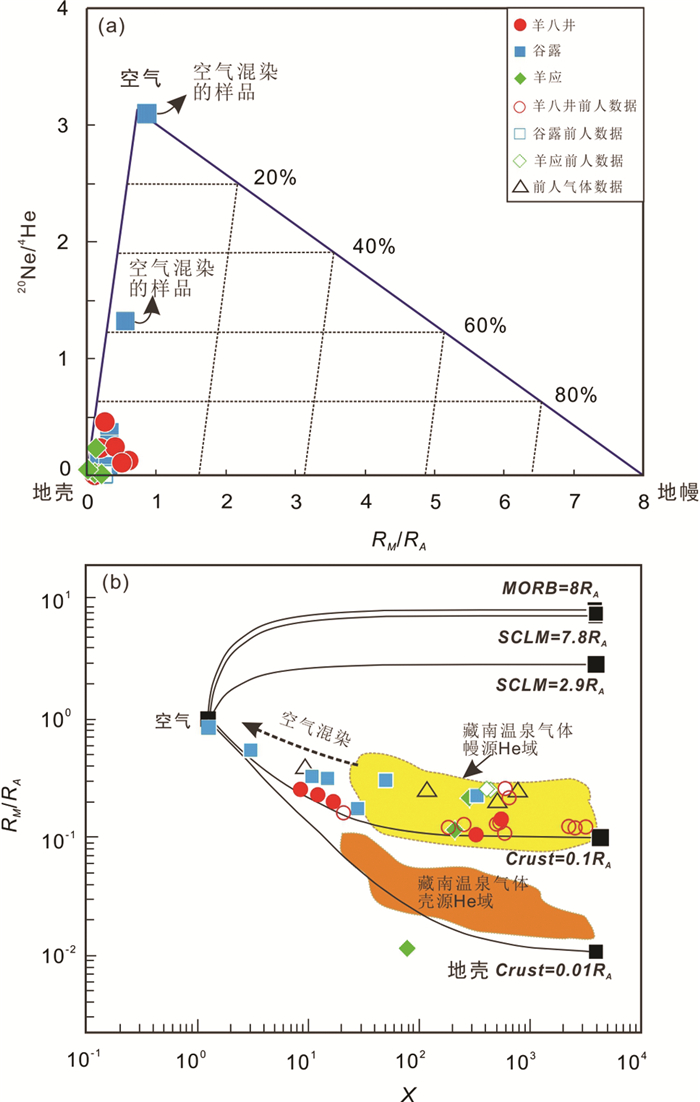
|
图 6 20Ne/4He与RM/RA相关图解(a, 底图据Lan et al., 2007)和RM/RA与大气校正参数X图解(b, 底图据Hoke et al., 2000) 图中空气(Air)、地壳(Crust)、洋中脊玄武岩(MORB)和岩石圈地幔(SCLM)的端元值分别引自Sano and Wakita (1985), Andrews (1985), Sano and Marty (1995)和Dunai and Baur (1995) Fig. 6 Correlation between 20Ne/4He and RM/RA of soil and hot springs gases from Gulu, Yangbajing and Yangying volcanic-geothermal fields (a, modified after Lan et al., 2007) and measured 3He/4He ratio versus X for soil and hot springs gases (b, after Hoke et al., 2000) Helium isotopic compositions for Air, Crust, MORB and SCLM are from Sano and Wakita (1985), Andrews (1985), Sano and Marty (1995) and Dunai and Baur (1995), respectively |
来源于深部地幔的火山-地热气体,其地球化学特征可能会受到多种地质过程的影响,例如,流体在地幔源区(例如,地幔的富集程度或受熔/流体交代程度)以及流体在运移过程时在地壳(岩浆混合、地壳混染和岩浆脱气等)和浅部地表(例如,地表空气或饱和地下水的混染等)所发生的物理、化学过程(Barry et al., 2013; Roulleau et al., 2015a, 2015b)。考虑到He同位素比值已经过大气校正处理,可排除浅部地表地质过程的影响,因此,谷露、羊八井和羊应火山-地热区气体较低的He同位素比值,可能主要受到以下2个方面的影响:
(1) 地壳的混染。研究表明,3He通过核衰变反应6Li (n, α) 3H (β-) He形成;4He是放射性元素U和Th衰变的产物,因此岩石中He同位素的组成与U、Th和Li的浓度密切相关(Craig and Lupton, 1976)。然而富含U和Th的拉萨地壳基岩,未能产生足量的4He使谷露、羊八井和羊应火山-地热区的3He/4He同位素比值低于0.10RA(Yokoyama et al., 1999),这说明地壳围岩的混染不是影响He同位素比值的最主要因素。
(2) 富集的地幔源区。大量研究资料(Wei et al., 2001; Xie et al., 2016; Zhang et al., 2017)表明,谷露-亚东裂谷下部发育岩浆房,岩浆房的熔体为来自深部富集地幔的钾质岩浆熔体,这些熔体释放富含3He的气体,形成了谷露-亚东裂谷内具有富集地幔性质火山-地热气体。此外,谷露-亚东裂谷内火山-地热区气体的He同位素比值在空间上呈现自南向北逐渐递增的趋势(表 2、图 7a),说明谷露-亚东裂谷带内火山-地热区气体的幔源3He通量从南向北呈递增的趋势(Hoke et al., 2000; Klemperer et al., 2013),同时也揭示裂谷内气体的源区的富集程度从南向北呈现递减的趋势。这与藏南俯冲成因的中新世钾质-超钾质岩的源区的富集程度的趋势变化是一致的(Guo et al., 2013, 2015)。因此,上述证据表明,谷露-亚东裂谷带的火山-地热区气体可能与印度大陆岩石圈的北向俯冲有关。
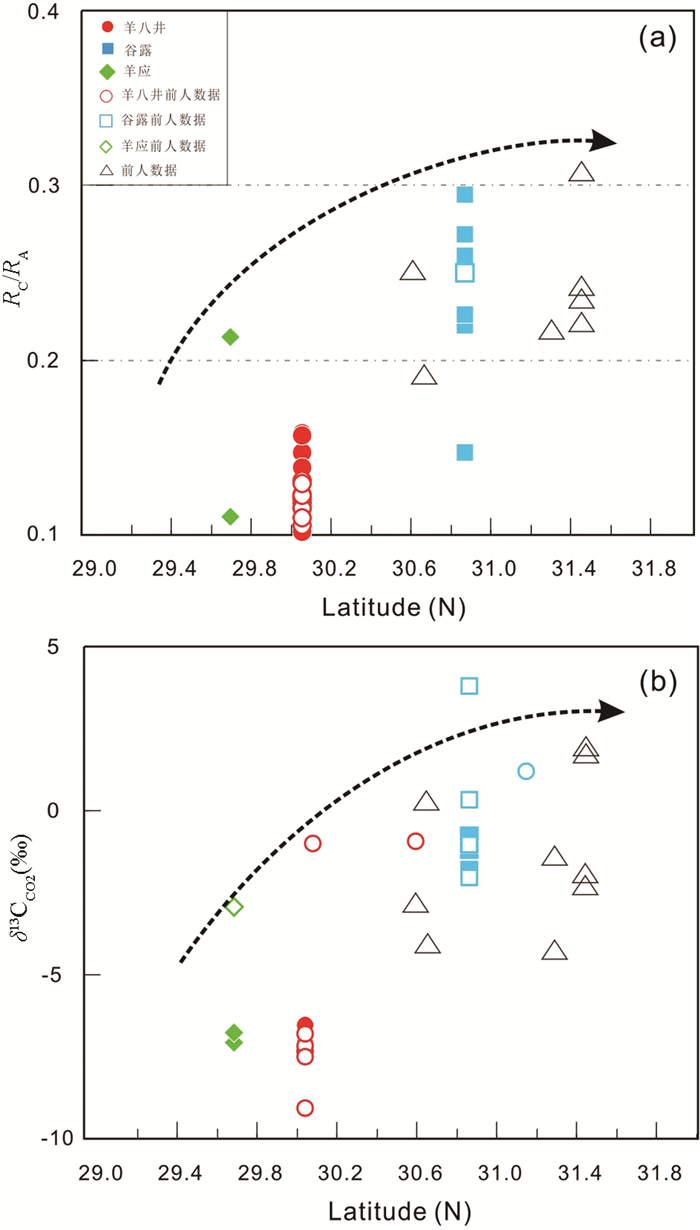
|
图 7 RC/RA(a)和δ13CCO2值(b)随纬度变化图解 Fig. 7 Air-correction 3He/4He ratios (a) and δ13CCO2 (b) values versus Latitude for soil and hot springs gases from volcanic-geothermal fields in the Gulu-Yadong rift |
此外,结合CO2-3He-4He图解(图 8),谷露、羊八井和羊应火山-地热区气体均具有较高的CO2/3He比值范围1.25×1010~2.21×1011,较低的3He/4He比值(0.11~0.29RA),几乎所有的样品落入大陆地壳成因的区域,符合大陆俯冲带火山-地热气体的特征。

|
图 8 CO2-3He-4He图解(底图据Hahm et al., 2008) 大洋岛弧玄武岩的He同位素比值(7.4±1.3RA; Sano and Fischer, 2013)和CO2/3He比值(15.7±11×109; Sano and Williams, 1996);洋中脊玄武岩的He同位素比值(8.0±1.5RA; Sano and Fischer, 2013)和CO2/3He比值(1.5×109; Sano and Marty, 1995) Fig. 8 Ternary plot of CO2, 3He and 4He for soil and hotsprings gases from Gulu, Yangbajing and Yangying volcanic-geothermal fields (modified after Hahm et al., 2008) |
δ13CCO2值是识别温室气体碳组分来源的重要参数(Sano and Marty, 1995)。研究表明,俯冲带火山-地热区的气体碳组分可能主要受再循环的地壳中的碳组分和上升过程中地壳混染的碳组分的影响(Hoefs, 2009)。结合气体的He同位素特征,火山-地热气体(流体)在上升过程中,影响谷露-亚东裂谷火山-地热气体δ13CCO2值的主要因素可能包括深部富集的岩浆房熔体及其烘烤的地壳围岩的成分(图 9)。
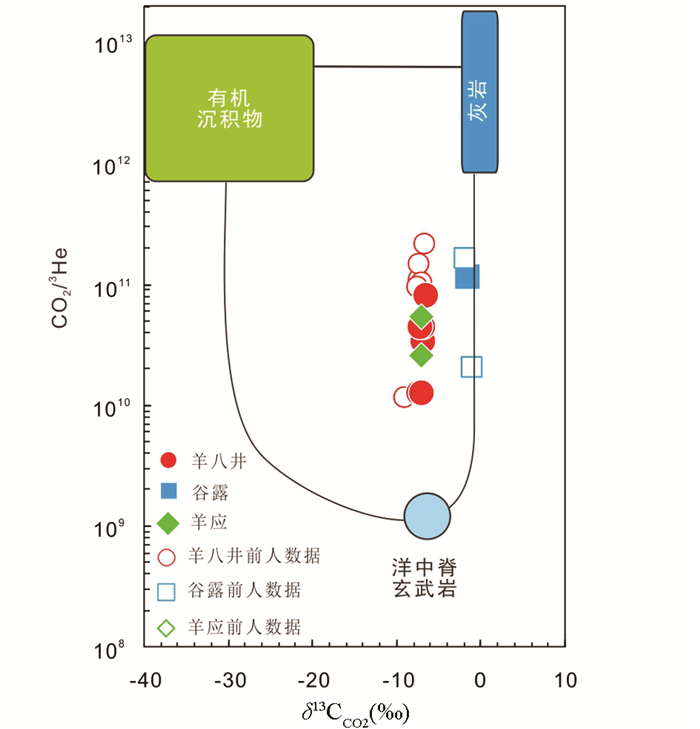
|
图 9 CO2/3He-δ13CCO2值相关图解(底图据Lan et al., 2007) 其中端元灰岩、有机沉积物和洋中脊玄武岩δ13CCO2值和CO2/3He比值引自Sano and Marty (1995) Fig. 9 Plot of CO2/3He vs. δ13CCO2 for soil and hot springs gases from Gulu, Yangbajing and Yangying volcanic-geothermal fields (modified after Lan et al., 2007) |
Liu et al. (2015)根据中新世钾质-超钾质岩的Os-Sr-Mg同位素组成特征认为,藏南地幔源区可能经历了碳酸岩流体的交代作用,藏南富集地幔可能为碳酸岩交代的地幔源区。此外,考虑到藏南地幔源区富集程度由南向北递减的趋势(Guo et al., 2013),富集的地幔来源的钾质岩熔体脱气形成气体的δ13CCO2值应该表现为自南向北逐渐递减的特点。这与谷露-亚东裂谷火山-地热区气体的δ13CCO2值在空间上呈现自南向北逐渐递增的趋势(表 2、图 7b)恰好相反,这说明谷露-亚东裂谷带内火山-地热区气体的碳组分可能主要受到拉萨地壳混染作用的影响,裂谷带C同位素的变化可能与南北方向上岩性化学成分的不同有关,即,谷露地热区的含碳酸岩矿物的复理石沉积、灰岩和板岩(Kidd et al., 1988; Yokoyama et al., 1999)不仅为谷露地热区提供了大量的CO2,同时也为谷露地热区提供了具有较重的δ13CCO2值的组分;而羊应-羊八井火山地热区较轻的C组分,可能受到南部硅酸盐以及有机沉积物提供的有机C的影响。
综上所述,谷露-亚东裂谷内火山-地热气体的形成可能包括两个阶段,(1)印度大陆岩石圈的北向俯冲、板片的后撤以及断离作用导致富集的钾质-超钾质熔体的上升,并且在谷露-亚东裂谷下部形成炙热的地壳岩浆房(Nábělek et al., 2009; Zhao et al., 2010; Guo et al., 2013, 2015; Zhang et al., 2017),为裂谷内火山-地热气体提供了源源不断的幔源组分(例如He、C等);(2)在炙热的岩浆囊烘烤下,上覆围岩,例如林子宗火山岩、冈底斯岩基、念青唐古拉花岗岩和含碳酸岩矿物的复理石沉积、灰岩和板岩等,将发生脱气作用,从而为裂谷内火山-地热区提供了充足的温室气体来源。
6 结论(1) 谷露和羊应火山-地热区土壤微渗漏CO2的平均释放通量分别为:437g·m-2·day-1和99g·m-2·day-1,每年向大气释放的CO2的规模为4.15×104t和5.42×104t。结合前期的研究工作和现有的地质资料,本文估算了谷露-亚东裂谷每年向大气圈释放的CO2总量为1.76×107t,接近西特提斯俯冲带前缘的意大利Apennine地区火山-地热区释放的CO2总量1.32×107t·a-1,结果表明大陆俯冲带是温室气体释放的重要场所。
(2) 谷露-亚东裂谷带中北部的羊八井和羊应火山-地热区释放的气体具有较低的3He/4He比值(0.1~0.21RA)和δ13CCO2值(-7.2‰~-6.52‰),整体上低于北部的谷露地热区气体的3He/4He比值(0.22~0.29RA)和δ13CCO2值(-2.03‰~0.79‰),并且在空间上He-C同位素表现为自南向北逐渐递增的趋势。结合岩石地球化学和地球物理证据,He同位素组分自南向北逐渐递增的趋势,为印度大陆岩石圈的北向俯冲提供了气体地球化学的证据;而C同位素值自南向北逐渐递增的趋势,暗示谷露-羊八井-羊应火山-地热区气体中的碳组分的变化与上覆拉萨地壳围岩中的碳组分的变化有关。
致谢 兰州油气资源中心李中平研究员、硕士研究生王希彬、胥旺提供了样品实验室测试的帮助;汉景泰研究员、顾兆炎研究员、樊祺诚研究员和李霓研究员为本文提出了建设性意见;两名审稿人为本文的完善提出了宝贵的意见;在此一并表示感谢。| [] | An ZS, Kutzbach JE, Prell WL, Porter SC. 2001. Evolution of Asian monsoons and phased uplift of the Himalaya-Tibetan Plateau since Late Miocene times. Nature , 411 (6833) :62–66. DOI:10.1038/35075035 |
| [] | Andrews JN. 1985. The isotopic composition of radiogenic helium and its use to study groundwater movement in confined aquifers. Chemical Geology , 49 (1-3) :339–351. DOI:10.1016/0009-2541(85)90166-4 |
| [] | Barry PH, Hilton DR, Fischer TP, de Moor JM, Mangasini F, Ramirez C. 2013. Helium and carbon isotope systematics of cold "mazuku" CO2 vents and hydrothermal gases and fluids from Rungwe Volcanic Province, southern Tanzania. Chemical Geology , 339 :141–156. DOI:10.1016/j.chemgeo.2012.07.003 |
| [] | Baubron JC, Rigo A, Toutain JP. 2002. Soil gas profiles as a tool to characterise active tectonic areas:The Jaut Pass example (Pyrenees, France). Earth and Planetary Science Letters , 196 (1-2) :69–81. DOI:10.1016/S0012-821X(01)00596-9 |
| [] | Bergfeld D, Goff F, Janik CJ. 2001. Elevated carbon dioxide flux at the Dixie Valley geothermal field, Nevada:Relations between surface phenomena and the geothermal reservoir. Chemical Geology , 177 (1-2) :43–66. DOI:10.1016/S0009-2541(00)00381-8 |
| [] | Blisniuk PM, Hacker BR, Glodny J, Ratschbacher L, Bi SW, Wu ZH, McWilliams MO, Calvert A. 2001. Normal faulting in central Tibet since at least 13. 5Myr ago. Nature , 412 (6847) :628–632. DOI:10.1038/35088045 |
| [] | Brombach T, Hunziker JC, Chiodini G, Cardellini C, Marini L. 2001. Soil diffuse degassing and thermal energy fluxes from the Southern Lakki plain, Nisyros (Greece). Geophysical Research Letters , 28 (1) :69–72. DOI:10.1029/2000GL008543 |
| [] | Brown LD, Zhao WJ, Nelson KD, Hauck M, Alsdorf D, Ross A, Cogan M, Clark M, Liu XW, Che JK. 1996. Bright spots, structure, and magmatism in Southern Tibet from INDEPTH seismic reflection profiling. Science , 274 (5293) :1688–1690. DOI:10.1126/science.274.5293.1688 |
| [] | Burnard P.2013. The Noble Gases as Geochemical Tracers. Berlin Heidelberg: Springer . |
| [] | Burton MR, Sawyer GM, Granieri D. 2013. Deep carbon emissions from volcanoes. Reviews in Mineralogy and Geochemistry , 75 (1) :323–354. DOI:10.2138/rmg.2013.75.11 |
| [] | Carapezza ML, Federico C. 2000. The contribution of fluid geochemistry to the volcano monitoring of Stromboli. Journal of Volcanology and Geothermal Research , 95 (1-4) :227–245. DOI:10.1016/S0377-0273(99)00128-6 |
| [] | Chen JL, Xu JF, Wang BQ, Kang ZQ. 2010. The relationship between the NS-trending grabens and the ultrapotassic volcanic rocks in Lhasa block, Qinghai-Tibetan Plateau. Acta Petrologica et Mineralogica , 29 (4) :341–354. |
| [] | Cheng ZH, Guo ZF, Zhang ML, Zhang LH. 2012. CO2 flux estimations of hot springs in the Tengchong Cenozoic volcanic field, Yunnan Province, SW China. Acta Petrologica Sinica , 28 (4) :1217–1224. |
| [] | Cheng ZH, Guo ZF, Zhang ML, Zhang LH. 2014. Carbon dioxide emissions from Tengchong Cenozoic volcanic field, Yunnan Province, SW China. Acta Petrologica Sinica , 30 (12) :3657–3670. |
| [] | Chiodini G, Cioni R, Guidi M, Raco B, Marini L. 1998. Soil CO2 flux measurements in volcanic and geothermal areas. Applied Geochemistry , 13 (5) :543–552. DOI:10.1016/S0883-2927(97)00076-0 |
| [] | Chiodini G, Frondini F, Cardellini C, Parello F, Peruzzi L. 2000. Rate of diffuse carbon dioxide Earth degassing estimated from carbon balance of regional aquifers:The case of central Apennine, Italy. Journal of Geophysical Research:Solid Earth (1978-2012) , 105 :8423–8434. DOI:10.1029/1999JB900355 |
| [] | Chiodini G, Marini L, Russo M. 2001. Geochemical evidence for the existence of high-temperature hydrothermal brines at Vesuvio volcano, Italy. Geochimica et Cosmochimica Acta , 65 (13) :2129–2147. DOI:10.1016/S0016-7037(01)00583-X |
| [] | Chiodini G, Baldini A, Barberi F, Carapezza ML, Cardellini C, Frondini F, Granieri D, Ranaldi M. 2007. Carbon dioxide degassing at Latera caldera (Italy):Evidence of geothermal reservoir and evaluation of its potential energy. Journal of Geophysical Research , 112 (B12) . DOI:10.1029/2006JB004896 |
| [] | Chiodini G, Caliro S, Cardellini C, Avino R, Granieri D, Schmidt A. 2008. Carbon isotopic composition of soil CO2 efflux, a powerful method to discriminate different sources feeding soil CO2 degassing in volcanic-hydrothermal areas. Earth and Planetary Science Letters , 274 (3-4) :372–379. DOI:10.1016/j.epsl.2008.07.051 |
| [] | Chiodini G, Vandemeulebrouck J, Caliro S, D'Auria L, De Martino P, Mangiacapra A, Petrillo Z. 2015. Evidence of thermal-driven processes triggering the 2005-2014 unrest at Campi Flegrei caldera. Earth and Planetary Science Letters , 414 :58–67. DOI:10.1016/j.epsl.2015.01.012 |
| [] | Cogan MJ, Nelson KD, Kidd WSF, Wu CD. 1998. Shallow structure of the Yadong-Gulu rift, southern Tibet, from refraction analysis of Project INDEPTH common midpoint data. Tectonics , 17 (1) :46–61. DOI:10.1029/97TC03025 |
| [] | Coleman M, Hodges K. 1995. Evidence for Tibetan plateau uplift before 14Myr ago from a new minimum age for east-west extension. Nature , 374 (6517) :49–52. DOI:10.1038/374049a0 |
| [] | Coulon C, Maluski H, Bollinger C, Wang S. 1986. Mesozoic and Cenozoic volcanic rocks from central and southern Tibet:39Ar-40Ar dating, petrological characteristics and geodynamical significance. Earth and Planetary Science Letters , 79 (3-4) :281–302. DOI:10.1016/0012-821X(86)90186-X |
| [] | Craig H, Lupton JE. 1976. Primordial neon, helium, and hydrogen in oceanic basalts. Earth and Planetary Science Letters , 31 (3) :369–385. DOI:10.1016/0012-821X(76)90118-7 |
| [] | Crossey LJ, Karlstrom KE, Springer AE, Newell D, Hilton DR, Fischer T. 2009. Degassing of mantle-derived CO2 and He from springs in the southern Colorado Plateau region-Neotectonic connections and implications for groundwater systems. Geological Society of America Bulletin , 121 (7-8) :1034–1053. DOI:10.1130/B26394.1 |
| [] | Dasgupta R, Hirschmann MM. 2010. The deep carbon cycle and melting in Earth's interior. Earth and Planetary Science Letters , 298 (1-2) :1–13. DOI:10.1016/j.epsl.2010.06.039 |
| [] | Ding L, Yue YH, Cai FL, Xu XX, Zhang QH, Lai QZ. 2006. 40Ar/39Ar geochronology, geochemical and Sr-Nd-O isotopic characteristics of the high-Mg ultrapotassic rocks in Lhasa block of Tibet:Implications in the onset time and depth of NS-striking rift system. Acta Geologica Sinica , 80 (9) :1252–1261. |
| [] | Dunai TJ, Baur H. 1995. Helium, neon, and argon systematics of the European subcontinental mantle:Implications for its geochemical evolution. Geochimica et Cosmochimica Acta , 59 (13) :2767–2783. DOI:10.1016/0016-7037(95)00172-V |
| [] | Dupont-Nivet G, Krijgsman W, Langereis CG, Abels HA, Dai S, Fang XM. 2007. Tibetan plateau aridification linked to global cooling at the Eocene-Oligocene transition. Nature , 445 (7128) :635–638. DOI:10.1038/nature05516 |
| [] | Edwards MA, Harrison TM. 1997. When did the roof collapse? Late Miocene north-south extension in the high Himalaya revealed by Th-Pb monazite dating of the Khula Kangri granite. Geology , 25 (6) :543–546. DOI:10.1130/0091-7613(1997)025<0543:WDTRCL>2.3.CO;2 |
| [] | Etiope G, Fridriksson T, Italiano F, Winiwarter W, Theloke J. 2007. Natural emissions of methane from geothermal and volcanic sources in Europe. Journal of Volcanology and Geothermal Research , 165 (1-2) :76–86. DOI:10.1016/j.jvolgeores.2007.04.014 |
| [] | Fischer TP, Giggenbach WF, Sano YJ, Williams SN. 1998. Fluxes and sources of volatiles discharged from Kudryavy, a subduction zone volcano, Kurile Islands. Earth and Planetary Science Letters , 160 (1-2) :81–96. DOI:10.1016/S0012-821X(98)00086-7 |
| [] | Fu CC, Yang TF, Walia V, Chen CH. 2005. Reconnaissance of soil gas composition over the buried fault and fracture zone in southern Taiwan. Geochemical Journal , 39 (5) :427–439. DOI:10.2343/geochemj.39.427 |
| [] | Furlong KP, Chapman DS. 2013. Heat flow, heat generation, and the thermal state of the lithosphere. Annual Review of Earth and Planetary Sciences , 41 (1) :385–410. DOI:10.1146/annurev.earth.031208.100051 |
| [] | Gerlach TM, Doukas MP, McGee KA, Kessler R. 2001. Soil efflux and total emission rates of magmatic CO2 at the Horseshoe Lake tree kill, Mammoth Mountain, California, 1995-1999. Chemical Geology , 177 (1-2) :101–116. DOI:10.1016/S0009-2541(00)00385-5 |
| [] | Guo ZF, Wilson M, Liu JQ. 2007. Post-collisional adakites in South Tibet:Products of partial melting of subduction-modified lower crust. Lithos , 96 (1-2) :205–224. DOI:10.1016/j.lithos.2006.09.011 |
| [] | Guo ZF, Li XH, Zhang ML. 2010. Volcanic activities and deep carbon cycle. Quaternary Sciences , 30 (3) :497–505. |
| [] | Guo ZF, Wilson M, Zhang ML, Cheng ZH, Zhang LH. 2013. Post-collisional, K-rich mafic magmatism in South Tibet:Constraints on Indian slab-to-wedge transport processes and plateau uplift. Contributions to Mineralogy and Petrology , 165 (6) :1311–1340. DOI:10.1007/s00410-013-0860-y |
| [] | Guo ZF, Zhang ML, Cheng ZH, Zhang LH, Liu JQ. 2014. Fluxes and genesis of greenhouse gases emissions from typical volcanic fields in China. Acta Petrologica Sinica , 30 (11) :3467–3480. |
| [] | Guo ZF, Wilson M, Zhang ML, Cheng ZH, Zhang LH. 2015. Post-collisional ultrapotassic mafic magmatism in South Tibet:Products of partial melting of pyroxenite in the mantle wedge induced by roll-back and delamination of the subducted Indian continental lithosphere slab. Journal of Petrology , 56 (7) :1365–1406. DOI:10.1093/petrology/egv040 |
| [] | Guo ZF, Zhang ML, Sun YT, Cheng ZH, Zhang LH, Liu JQ. 2015. Research advances in Greenhouse gases degassing from Cenozoic volcanic active fields. Bulletin of Mineralogy, Petrology and Geochemistry , 34 (4) :690–700. |
| [] | Guo ZT, Ruddiman WF, Hao QZ, Wu HB, Qiao YS, Zhu RX, Peng SZ, Wei JJ, Yuan BY, Liu TS. 2002. Onset of Asian desertification by 22Myr ago inferred from loess deposits in China. Nature , 416 (6877) :159–163. DOI:10.1038/416159a |
| [] | Hahm D, Hilton DR, Cho M, Wei H, Kim KR. 2008. Geothermal He and CO2 variations at Changbaishan intra-plate volcano (NE China) and the nature of the sub-continental lithospheric mantle. Geophysical Research Letters , 35 (22) :L22304. DOI:10.1029/2008GL035955 |
| [] | Hamme RC, Emerson SR. 2004. The solubility of neon, nitrogen and argon in distilled water and seawater. Deep Sea Research Part Ⅰ:Oceanographic Research Papers , 51 (11) :1517–1528. DOI:10.1016/j.dsr.2004.06.009 |
| [] | Harrison TM, Copeland P, Kidd WSF, Lovera OM. 1995. Activation of the Nyainqentanghla shear zone:Implications for uplift of the southern Tibetan Plateau. Tectonics , 14 (3) :658–676. DOI:10.1029/95TC00608 |
| [] | He RZ, Gao R. 2003. Some significances of studying north-southern rift in Tibet Plateau. Progress in Geophysics , 18 (1) :35–43. |
| [] | Hernández PA, Salazar JM, Shimoike Y, Mori T, Notsu K, Pérez N. 2001. Diffuse emission of CO2 from Miyakejima volcano, Japan. Chemical Geology , 177 (1-2) :175–185. DOI:10.1016/S0009-2541(00)00390-9 |
| [] | Hilton DR, Gronvold K, Sveinbjornsdottir AE, Hammerschmidt K. 1998. Helium isotope evidence for off-axis degassing of the Icelandic hotspot. Chemical Geology , 149 (3-4) :173–187. DOI:10.1016/S0009-2541(98)00044-8 |
| [] | Hilton DR, Fischer TP, Marty B. 2002. Noble gases and volatile recycling at subduction zones. Reviews in Mineralogy and Geochemistry , 47 (1) :319–370. DOI:10.2138/rmg.2002.47.9 |
| [] | Hoefs J.2009. Stable Isotope Geochemistry. Berlin Heidelberg: Springer-Verlag . |
| [] | Hoke L, Lamb S, Hilton DR, Poreda RJ. 2000. Southern limit of mantle-derived geothermal helium emissions in Tibet:Implications for lithospheric structure. Earth and Planetary Science Letters , 180 (3-4) :297–308. DOI:10.1016/S0012-821X(00)00174-6 |
| [] | Hou ZQ, Li ZQ, Qu XM, Gao YF, Hua LC, Zheng MP, Li SR, Yuan WM. 2001. The uplifting processes of the Tibetan Plateau since 0.5Ma B.P.:Evidence from hydrothermal activity in the Gangdise Belt. Science in China (Series D) , 3l (Suppl.) :35–44. |
| [] | Hou ZQ, Li ZQ. 2004. Possible location for underthrusting front of the Indus continent:Constraints from helium isotope of the geothermal gas in southern Tibet and eastern Tibet. Acta Geologica Sinica , 78 (4) :482–493. |
| [] | Hutchison W, Mather TA, Pyle DM, Biggs J, Yirgu G. 2015. Structural controls on fluid pathways in an active rift system:A case study of the Aluto volcanic complex. Geosphere , 11 (3) :542–562. DOI:10.1130/GES01119.1 |
| [] | Ji WQ, Wu FY, Liu CZ, Chung S. 2009. Geochronology and petrogenesis of granitic rocks in Gangdese batholith, southern Tibet. Science in China (Series D) , 52 (9) :1240–1261. DOI:10.1007/s11430-009-0131-y |
| [] | Kapp JLD, Harrison TM, Kapp P, Grove M, Lovera OM, Lin D. 2005. Nyainqentanglha Shan:A window into the tectonic, thermal, and geochemical evolution of the Lhasa block, southern Tibet. Journal of Geophysical Research , 110 (B8) :B08413. |
| [] | Karlstrom KE, Crossey LJ, Hilton DR, Barry PH. 2013. Mantle 3He and CO2 degassing in carbonic and geothermal springs of Colorado and implications for neotectonics of the Rocky Mountains. Geology , 41 (4) :495–498. DOI:10.1130/G34007.1 |
| [] | Kelemen PB, Manning CE. 2015. Reevaluating carbon fluxes in subduction zones, what goes down, mostly comes up. Proceedings of the National Academy of Sciences of the United States of America , 112 (30) :E3997–E4006. DOI:10.1073/pnas.1507889112 |
| [] | Kerrick DM, Caldeira K. 1999. Was the Himalayan orogen a climatically significant coupled source and sink for atmospheric CO2 during the Cenozoic?. Earth and Planetary Science Letters , 173 (3) :195–203. DOI:10.1016/S0012-821X(99)00229-0 |
| [] | Kidd WSF, Pan YS, Chang CF, Coward MP, Dewey JF, Gansser A, Molnar P, Shackleton RM, Sun YY. 1988. Geological mapping of the 1985 Chinese-British Tibetan (Xizang-Qinghai) Plateau geotraverse route. Philosophical Transactions of the Royal Society A:Mathematical, Physical and Engineering Sciences , 327 (1594) :287–305. DOI:10.1098/rsta.1988.0130 |
| [] | Klemperer SL, Kennedy BM, Sastry SR, Makovsky Y, Harinarayana T, Leech ML. 2013. Mantle fluids in the Karakoram fault:Helium isotope evidence. Earth and Planetary Science Letters , 366 :59–70. DOI:10.1016/j.epsl.2013.01.013 |
| [] | Kulongoski JT, Hilton DR, Barry PH, Esser BK, Hillegonds D, Belitz K. 2013. Volatile fluxes through the Big Bend section of the San Andreas Fault, California:Helium and carbon-dioxide systematics. Chemical Geology , 339 :92–102. DOI:10.1016/j.chemgeo.2012.09.007 |
| [] | Lan TF, Yang TF, Lee HF, Chen YG, Chen CH, Song SR, Tsao S. 2007. Compositions and flux of soil gas in Liu-Huang-Ku hydrothermal area, northern Taiwan. Journal of Volcanology and Geothermal Research , 165 (1-2) :32–45. DOI:10.1016/j.jvolgeores.2007.04.015 |
| [] | Lee HY, Chung SL, Ji JQ, Qian Q, Gallet S, Lo CH, Lee TY, Zhang Q. 2012. Geochemical and Sr-Nd isotopic constraints on the genesis of the Cenozoic Linzizong volcanic successions, southern Tibet. Journal of Asian Earth Sciences , 53 :96–114. DOI:10.1016/j.jseaes.2011.08.019 |
| [] | Lewicki JL, Connor C, St-Amand K, Stix J, Spinner W. 2003. Self-potential, soil CO2 flux, and temperature on Masaya volcano, Nicaragua. Geophysical Research Letters , 30 (15) :1817. |
| [] | Li H, Peng SB, Qiao WT, Lin MS, Wang ZS, Tian LQ. 2011. The distribution and activity of Cenozoic magma chamber in Tengchong volcano area deduced from the MODIS multi-temporal monthly night LST data. Acta Petrologica Sinica , 27 (10) :2873–2882. |
| [] | Li JZ, Zhang YY, Luo HY. 1992. A research on petrological characters and genesis of the Cenozoic volcanic rocks in the Yangying village geothermal field, Dangxiong, Tibet, China. Geoscience , 6 (1) :96–109. |
| [] | Li JZ, Sun SP, Zhang YY, Luo HY. 1994. A study on formation characteristics and appraisal of the Yangying village geothermal field, Dangxiong, Tibet. Geoscience , 8 (1) :49–56. |
| [] | Liao ZJ, Zhao P.1999. Yunnan-Tibet Geothermal Belt:Geothermal Resources and Case Histories. Beijing: Science Press : 1 -153. |
| [] | Liu D, Zhao ZD, Zhu DC, Niu YL, Widom E, Teng FZ, DePaolo DJ, Ke S, Xu JF, Wang Q, Mo XX. 2015. Identifying mantle carbonatite metasomatism through Os-Sr-Mg isotopes in Tibetan ultrapotassic rocks. Earth and Planetary Science Letters , 430 :458–469. DOI:10.1016/j.epsl.2015.09.005 |
| [] | Liu QS, Wu ZH, Hu DG, Ye PS, Jiang W, Wang YB, Zhang HC. 2004. SHRIMP U-Pb zircon dating on Nyainqentanglha granite in central Lhasa block. Chinese Science Bulletin , 49 (1) :76–82. DOI:10.1007/BF02901746 |
| [] | Liu Z. 2014. The forming mechanism of typical high-temperature geothermal systems in Nimu-Naqu geothermal belt, Tibet. Ph. D. Dissertation. Beijing:Chinese Academy of Geological Sciences (in Chinese with English summary) |
| [] | Luo M, Huang HG, Zhang P, Wu QB, Chen DF. 2014. Origins of gas discharging from the Qiangtang Basin in the northern Qinghai-Tibet Plateau, China:Evidence from gas compositions, helium, and carbon isotopes. Journal of Geochemical Exploration , 146 :119–126. DOI:10.1016/j.gexplo.2014.08.006 |
| [] | Lupton JE. 1983. Terrestrial inert gases:Isotope tracer studies and clues to primordial components in the mantle. Annual Review of Earth and Planetary Sciences , 11 (1) :371–414. DOI:10.1146/annurev.ea.11.050183.002103 |
| [] | Maheshwari A, Sial AN, Chittora VK. 1999. High-δ13C Paleoproterozoic carbonates from the Aravalli Supergroup, Western India. International Geology Review , 41 (10) :949–954. DOI:10.1080/00206819909465181 |
| [] | Marty B, Gunnlaugsson E, Jambon A, Oskarsson N, Ozima M, Pineau F, Torssander P. 1991. Gas geochemistry of geothermal fluids, the Hengill area, southwest rift zone of Iceland. Chemical Geology , 91 (3) :207–225. DOI:10.1016/0009-2541(91)90001-8 |
| [] | Marty B, Tolstikhin IN. 1998. CO2 fluxes from mid-ocean ridges, arcs and plumes. Chemical Geology , 145 (3-4) :233–248. DOI:10.1016/S0009-2541(97)00145-9 |
| [] | Mo XX, Zhao ZD, DePaolo DJ, Zhou S, Dong GC. 2006. Three types of collisional and post-collisional magmatism in the Lhasa block, Tibet and implications for India intra-continental subduction and mineralization:Evidence from Sr-Nd isotopes. Acta Petrologica Sinica , 22 (4) :795–803. |
| [] | Nábělek J, Hetényi G, Vergne J, Sapkota S, Kafle B, Jiang M, Su HP, Chen J, Huang BS, The Hi-CLIMB Team. 2009. Underplating in the Himalaya-Tibet collision zone revealed by the Hi-CLIMB experiment. Science , 325 (5946) :1371–1374. DOI:10.1126/science.1167719 |
| [] | Nelson KD, Zhao WJ, Brown LD, Kuo J, Che JK, Liu XW, Klemperer SL, Makovsky Y, Meissner R, Mechie J, Kind R, Wenzel F, Ni J, Nabelek J, Chen LS, Tan HD, Wei WB, Jones AG, Booker J, Unsworth M, Kidd WSF, Hauck M, Alsdorf D, Ross A, Cogan M, Wu CD, Sandvol E, Edwards M. 1996. Partially molten middle crust beneath southern Tibet:Synthesis of project INDEPTH results. Science , 274 (5293) :1684–1688. DOI:10.1126/science.274.5293.1684 |
| [] | Newell DL, Jessup MJ, Cottle JM, Hilton DR, Sharp ZD, Fischer TP. 2008. Aqueous and isotope geochemistry of mineral springs along the southern margin of the Tibetan plateau:Implications for fluid sources and regional degassing of CO2. Geochemistry, Geophysics, Geosystems , 9 (8) :Q08014. |
| [] | Nomade S, Renne PR, Mo XX, Zhao ZD, Zhou S. 2004. Miocene volcanism in the Lhasa block, Tibet:Spatial trends and geodynamic implications. Earth and Planetary Science Letters , 221 (1-4) :227–243. DOI:10.1016/S0012-821X(04)00072-X |
| [] | O'Nions RK, Oxburgh ER. 1988. Helium, volatile fluxes and the development of continental crust. Earth and Planetary Science Letters , 90 (3) :331–347. DOI:10.1016/0012-821X(88)90134-3 |
| [] | Ray JS, Ramesh R, Pande K. 1999. Carbon isotopes in Kerguelen plume-derived carbonatites:Evidence for recycled inorganic carbon. Earth and Planetary Science Letters , 170 (3) :205–214. DOI:10.1016/S0012-821X(99)00112-0 |
| [] | Resing JA, Lupton JE, Feely RA, Lilley MD. 2004. CO2 and 3He in hydrothermal plumes:Implications for mid-ocean ridge CO2 flux. Earth and Planetary Science Letters , 226 (3-4) :449–464. DOI:10.1016/j.epsl.2004.07.028 |
| [] | Roulleau E, Sano Y, Takahata N, Yang FT, Takahashi HA. 2015a. He, Ar, N and C isotope compositions in Tatun Volcanic Group (TVG), Taiwan:Evidence for an important contribution of pelagic carbonates in the magmatic source. Journal of Volcanology and Geothermal Research , 303 :7–15. DOI:10.1016/j.jvolgeores.2015.07.017 |
| [] | Roulleau E, Vinet N, Sano Y, Takahata N, Shinohara H, Ooki M, Takahashi HA, Furukawa R. 2015b. Effect of the volcanic front migration on helium, nitrogen, argon, and carbon geochemistry of hydrothermal/magmatic fluids from Hokkaido volcanoes, Japan. Chemical Geology , 414 :42–58. DOI:10.1016/j.chemgeo.2015.08.006 |
| [] | Sano Y, Wakita H. 1985. Geographical distribution of 3He/4He ratios in Japan:Implications for arc tectonics and incipient magmatism. Journal of Geophysical Research , 90 (B10) :8729–8741. DOI:10.1029/JB090iB10p08729 |
| [] | Sano Y, Wakita H, Makide Y, Tominaga T. 1989. A ten-year decrease in the atmospheric helium isotope ratio possibly caused by human activity. Geophysical Research Letters , 16 (12) :1371–1374. DOI:10.1029/GL016i012p01371 |
| [] | Sano Y, Marty B. 1995. Origin of carbon in fumarolic gas from island arcs. Chemical Geology , 119 (1-4) :265–274. DOI:10.1016/0009-2541(94)00097-R |
| [] | Sano Y, Williams SN. 1996. Fluxes of mantle and subducted carbon along convergent plate boundaries. Geophysical Research Letters , 23 (20) :2749–2752. DOI:10.1029/96GL02260 |
| [] | Sano Y and Fischer TP. 2013. The analysis and interpretation of noble gases in modern hydrothermal systems. In:Burnard P (ed.). The Noble Gases as Geochemical Tracers. Berlin Heidelberg:Springer-Verlag, 249-317 |
| [] | Sano Y, Hara T, Takahata N, Kawagucci S, Honda M, Nishio Y, Tanikawa W, Hasegawa A, Hattori K. 2014. Helium anomalies suggest a fluid pathway from mantle to trench during the 2011 Tohoku-Oki earthquake. Nature Communications , 5 :3084. |
| [] | Schmidt MW and Poli S. 2014. Devolatilization during subduction. In:Holland HD and Turekian KK (eds.). Treatise on Geochemistry. 2nd Edition. Oxford:Elsevier-Pergamon, 669-701 |
| [] | Shinohara H. 2013. Volatile flux from subduction zone volcanoes:Insights from a detailed evaluation of the fluxes from volcanoes in Japan. Journal of Volcanology and Geothermal Research , 268 :46–63. DOI:10.1016/j.jvolgeores.2013.10.007 |
| [] | Sinclair AJ. 1974. Selection of threshold values in geochemical data using probability graphs. Journal of Geochemical Exploration , 3 (2) :129–149. DOI:10.1016/0375-6742(74)90030-2 |
| [] | Tonani F and Miele G. 1991. Methods for measuring flow of carbon dioxide through soils in the volcanic setting. International Conference on Active Volcanoes and Risk Mitigation. Naples, Italy:IAVCEI |
| [] | Walia V, Quattrocchi F, Virk HS, Yang TF, Pizzino L, Bajwa BS. 2005. Radon, helium and uranium survey in some thermal springs located in NW Himalayas, India:Mobilization by tectonic features or by geochemical barriers?. Journal of Environmental Monitoring , 7 (9) :850–855. DOI:10.1039/b419135h |
| [] | Wang BD, Chen LK, Xu JF, Liu HF, Chen JL, Kang ZQ. 2011. Identification and petrogenesis of potassic volcanicrocks with "ultrapotassic" characteristics from Maqiang area in Lhasa block. Acta Petrologica Sinica , 27 (6) :1662–1674. |
| [] | Wei WB, Unsworth M, Jones A, Booker J, Tan HD, Nelson D, Chen LS, Li SH, Solon K, Bedrosian P, Jin S, Deng M, Ledo J, Kay D, Roberts B. 2001. Detection of widespread fluids in the Tibetan crust by magnetotelluric studies. Science , 292 (5517) :716–719. DOI:10.1126/science.1010580 |
| [] | Weinlich FH, Bräuer K, Kämpf H, Strauch G, Tesař J, Weise SM. 1999. An active subcontinental mantle volatile system in the western Eger rift, Central Europe:Gas flux, isotopic (He, C, and N) and compositional fingerprints. Geochimica et Cosmochimica Acta , 63 (21) :3653–3671. DOI:10.1016/S0016-7037(99)00187-8 |
| [] | Weiss RF. 1971. Solubility of helium and neon in water and seawater. Journal of Chemical & Engineering Data , 16 (2) :235–241. |
| [] | Weller OM, St-Onge MR, Rayner N, Searle MP, Waters DJ. 2016. Weller OM, St-Onge MR, Rayner N, Searle MP and Waters DJ. Lithos , 245 :147–160. DOI:10.1016/j.lithos.2015.06.024 |
| [] | Werner C, Hurwitz S, Evans WC, Lowenstern JB, Bergfeld D, Heasler H, Jaworowski C, Hunt A. 2008. Volatile emissions and gas geochemistry of Hot Spring Basin, Yellowstone National Park, USA. Journal of Volcanology and Geothermal Research , 178 (4) :751–762. DOI:10.1016/j.jvolgeores.2008.09.016 |
| [] | Williams H, Turner S, Kelley S, Harris N. 2001. Age and composition of dikes in Southern Tibet:New constraints on the timing of east-west extension and its relationship to postcollisional volcanism. Geology , 29 (4) :339–342. DOI:10.1130/0091-7613(2001)029<0339:AACODI>2.0.CO;2 |
| [] | Wu CD, Nelson KD, Wortman G, Samson SD, Yue YJ, Li JX, Kidd WSF, Edwards MA. 1998. Yadong cross structure and South Tibetan Detachment in the east central Himalaya (89°~90°E). Tectonics , 17 (1) :28–45. DOI:10.1029/97TC03386 |
| [] | Wu GX, Liu YM, He B, Bao Q, Duan AM, Jin FF. 2012. Thermal controls on the Asian summer monsoon. Scientific Reports , 2 :404. |
| [] | Wu ZH, Hu DG, Liu QS, Ye PS, Wu ZH. 2005. Chronological analyses of the thermal evolution of granite and the uplift process of the Nyainqentanglha Range in Central Tibet. Acta Geoscientica Sinica , 26 (06) :505–512. |
| [] | Xie CL, Jin S, Wei WB, Ye GF, Jing JE, Zhang LT, Dong H, Yin YT, Wang G, Xia RX. 2016. Crustal electrical structures and deep processes of the eastern Lhasa terrane in the South Tibetan Plateau as revealed by magnetotelluric data. Tectonophysics , 675 :168–180. DOI:10.1016/j.tecto.2016.03.017 |
| [] | Yang ZM, Lu YJ, Hou ZQ, Chang ZS. 2015. High-Mg diorite from Qulong in southern Tibet:Implications for the genesis of adakite-like intrusions and associated porphyry Cu deposits in collisional orogens. Journal of Petrology , 56 (2) :227–254. DOI:10.1093/petrology/egu076 |
| [] | Yokoyama T, Nakai S, Wakita H. 1999. Helium and carbon isotopic compositions of hot spring gases in the Tibetan Plateau. Journal of Volcanology and Geothermal Research , 88 (1-2) :99–107. DOI:10.1016/S0377-0273(98)00108-5 |
| [] | Zellmer GF, Hwang SL, Sakamoto N, Iizuka Y, Harada S, Kimura JI, Tamura Y, Yurimoto H. 2015. Interaction of arc magmas with subvolcanic hydrothermal systems:Insights from compositions and metasomatic textures of olivine crystals in fresh basalts of Daisen and Mengameyama, Western Honshu, Japan. In:Zellmer GF, Edmonds M and Straub SM (eds.). The Role of Volatiles in the Genesis, Evolution and Eruption of Arc Magmas. Geological Society, London, Special Publications , 410 (1) :219–236. |
| [] | Zhang LH, Guo ZF, Zhang ML, Cheng ZH. 2014. Study on soil micro-seepage gas flux in the high temperature geothermal area:An Example from the Yangbajing geothermal field, South Tibet. Acta Petrologica Sinica , 30 (12) :3612–3626. |
| [] | Zhang LH, Guo ZF, Zhang ML, Cheng ZH, Sun YT. 2017. Post-collisional potassic magmatism in the eastern Lhasa terrane, South Tibet:Products of partial melting of mélanges in a continental subduction channel. Gondwana Research , 41 :9–28. DOI:10.1016/j.gr.2015.11.007 |
| [] | Zhang ML, Guo ZF, Cheng ZH, Zhang LH, Guo WF. 2011. Advances of research on greenhouse gases degassing from volcanic fields. Advances in Earth Sciences , 26 (12) :1235–1247. |
| [] | Zhang ML, Guo ZF, Sano Y, Cheng ZH, Zhang LH. 2015. Stagnant subducted Pacific slab-derived CO2 emissions:Insights into magma degassing at Changbaishan volcano, NE China. Journal of Asian Earth Sciences , 106 :49–63. DOI:10.1016/j.jseaes.2015.01.029 |
| [] | Zhang ML, Guo ZF, Sano Y, Zhang LH, Sun YT, Cheng ZH, Yang TF. 2016. Magma-derived CO2 emissions in the Tengchong volcanic field, SE Tibet:Implications for deep carbon cycle at intra-continent subduction zone. Journal of Asian Earth Sciences , 127 :76–90. DOI:10.1016/j.jseaes.2016.06.009 |
| [] | Zhao JM, Yuan XH, Liu HB, Kumar P, Pei SP, Kind R, Zhang ZJ, Teng JW, Ding L, Gao X, Xu Q, Wang W. 2010. The boundary between the Indian and Asian tectonic plates below Tibet. Proceedings of the National Academy of Sciences of the United States of America , 107 (25) :11229–11233. DOI:10.1073/pnas.1001921107 |
| [] | Zhao P, Kennedy M, Dor J, Xie EJ, Du SP, Shuster D, Jin J. 2001. Noble gases constraints on the origin and evolution of geothermal fluids from the Yangbajain geothermal field, Tibet. Acta Petrologica Sinica , 17 (3) :497–503. |
| [] | Zhao P, Xie EJ, Dor J, Jin J, Hu XC, Du SP, Yao ZH. 2002. Geochemical characteristics of geothermal gases and their geological implications in Tibet. Acta Petrologica Sinica , 18 (4) :539–550. |
| [] | Zhao WJ, Nelson KD, Che J, Quo J, Lu D, Wu C, Liu X. 1993. Deep seismic reflection evidence for continental underthrusting beneath southern Tibet. Nature , 366 (6455) :557–559. DOI:10.1038/366557a0 |
| [] | Zhao ZD, Mo XX, Nomade S, Renne PR, Zhou S, Dong GC, Wang LL, Zhu DC, Liao ZL. 2006. Post-collisional ultrapotassic rocks in Lhasa Block, Tibetan Plateau:Spatial and temporal distribution and its' implications. Acta Petrologica Sinica , 22 (4) :787–794. |
| [] | Zhao ZD, Mo XX, Dilek Y, Niu YL, DePaolo DJ, Robinson P, Zhu DC, Sun CG, Dong GC, Zhou S, Luo ZH, Hou ZQ. 2009. Geochemical and Sr-Nd-Pb-O isotopic compositions of the post-collisional ultrapotassic magmatism in SW Tibet:Petrogenesis and implications for India intra-continental subduction beneath southern Tibet. Lithos , 113 (1-2) :190–212. DOI:10.1016/j.lithos.2009.02.004 |
| [] | Zheng HB, Wei XC, Tada R, Clift PD, Wang B, Jourdan F, Wang P, He MY. 2015. Late Oligocene-Early Miocene birth of the Taklimakan Desert. Proceedings of the National Academy of Sciences of the United States of America , 112 (25) :7662–7667. DOI:10.1073/pnas.1424487112 |
| [] | Zhu DC, Wang Q, Zhao ZD, Chung SL, Cawood PA, Niu YL, Liu SA, Wu FY, Mo XX. 2015. Magmatic record of India-Asia collision. Scientific Reports , 5 :14289. DOI:10.1038/srep14289 |
| [] | 陈建林, 许继峰, 王保弟, 康志强.2010. 青藏高原拉萨地块新生代超钾质岩与南北向地堑成因关系. 岩石矿物学杂志 , 29 (4) :341–354. |
| [] | 成智慧, 郭正府, 张茂亮, 张丽红.2012. 腾冲新生代火山区温泉CO2气体排放通量研究. 岩石学报 , 28 (4) :1217–1224. |
| [] | 成智慧, 郭正府, 张茂亮, 张丽红.2014. 腾冲新生代火山区CO2气体释放通量及其成因. 岩石学报 , 30 (12) :3657–3670. |
| [] | 丁林, 岳雅慧, 蔡福龙, 徐晓霞, 张清海, 来庆洲.2006. 西藏拉萨地块高镁超钾质火山岩及对南北向裂谷形成时间和切割深度的制约. 地质学报 , 80 (9) :1252–1261. |
| [] | 郭正府, 李晓惠, 张茂亮.2010. 火山活动与深部碳循环的关系. 第四纪研究 , 30 (3) :497–505. |
| [] | 郭正府, 张茂亮, 成智慧, 张丽红, 刘嘉麒.2014. 中国大陆新生代典型火山区温室气体释放的规模及其成因. 岩石学报 , 30 (11) :3467–3480. |
| [] | 郭正府, 张茂亮, 孙玉涛, 成智慧, 张丽红, 刘嘉麒.2015. 火山温室气体释放通量与观测的研究进展. 矿物岩石地球化学通报 , 34 (4) :690–700. |
| [] | 贺日政, 高锐.2003. 西藏高原南北向裂谷研究意义. 地球物理学进展 , 18 (1) :35–43. |
| [] | 侯增谦, 李振清, 曲晓明, 高永丰, 华力臣, 郑绵平, 李胜荣, 袁万明.2001. 0.5Ma以来的青藏高原隆升过程--来自冈底斯带热水活动的证据. 中国科学(D辑) , 31 (增刊) :27–33. |
| [] | 侯增谦, 李振清.2004. 印度大陆俯冲前缘的可能位置:来自藏南和藏东活动热泉气体He同位素约束. 地质学报 , 78 (4) :482–493. |
| [] | 李辉, 彭松柏, 乔卫涛, 林木森, 王振胜, 田礼乔.2011. 根据多时相夜间MODIS LST推断的腾冲地区新生代火山岩岩浆囊分布与活动特征. 岩石学报 , 27 (10) :2873–2882. |
| [] | 李家振, 张有瑜, 骆红羿.1992. 西藏当雄羊应乡地热田新生代火山岩特征及其成因探讨. 现代地质 , 6 (1) :96–109. |
| [] | 李家振, 孙善平, 张有瑜, 骆红羿.1994. 西藏羊应乡地热田形成特点及评价探讨. 现代地质 , 8 (1) :49–56. |
| [] | 廖志杰, 赵平. 1999. 滇藏地热带--地热资源和典型地热系统. 北京: 科学出版社 : 1 -153. |
| [] | 刘昭. 2014.西藏尼木-那曲地热带典型高温地热系统形成机理研究.博士学位论文.北京:中国地质科学院 |
| [] | 莫宣学, 赵志丹, DePaoloDJ, 周肃, 董国臣.2006. 青藏高原拉萨地块碰撞-后碰撞岩浆作用的三种类型及其对大陆俯冲和成矿作用的启示:Sr-Nd同位素证据. 岩石学报 , 22 (4) :795–803. |
| [] | 王保弟, 陈陵康, 许继峰, 刘鸿飞, 陈建林, 康志强.2011. 拉萨地块麻江地区具有"超钾质"成分的钾质火山岩的识别及成因. 岩石学报 , 27 (6) :1662–1674. |
| [] | 吴珍汉, 胡道功, 刘琦胜, 叶培盛, 吴中海.2005. 念青唐古拉花岗岩热演化历史和山脉隆升过程的热年代学分析. 地球学报 , 26 (6) :505–512. |
| [] | 张丽红, 郭正府, 张茂亮, 成智慧.2014. 高温地热区土壤微渗漏的温室气体释放通量研究:以藏南羊八井地热田为例. 岩石学报 , 30 (12) :3612–3626. |
| [] | 张茂亮, 郭正府, 成智慧, 张丽红, 郭文峰.2011. 火山区温室气体排放研究进展. 地球科学进展 , 26 (12) :1235–1247. |
| [] | 赵平, KennedyM, 多吉, 谢鄂军, 杜少平, ShusterD, 金建.2001. 西藏羊八井热田地热流体成因及演化的惰性气体制约. 岩石学报 , 17 (3) :497–503. |
| [] | 赵平, 谢鄂军, 多吉, 金建, 胡先才, 杜少平, 姚中华.2002. 西藏地热气体的地球化学特征及其地质意义. 岩石学报 , 18 (4) :539–550. |
| [] | 赵志丹, 莫宣学, NomadeS, RennePR, 周肃, 董国臣, 王亮亮, 朱弟成, 廖忠礼.2006. 青藏高原拉萨地块碰撞后超钾质岩石的时空分布及其意义. 岩石学报 , 22 (4) :787–794. |
 2017, Vol. 33
2017, Vol. 33






